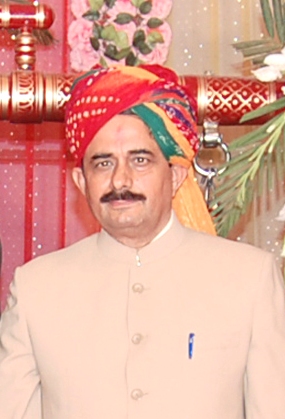Prachin Bharat ko Jat ki Dain
| Author of this article is Laxman Burdak लक्ष्मण बुरड़क |

प्राचीन भारत को जाट की देन
यह शीर्षक है श्री कृष्ण चन्द्र दहिया द्वारा लिखित पुस्तक का जो वर्ष 2012 में प्रकाशित हुई है.
पुस्तक का विवरण
पुस्तक का विवरण निम्नानुसार है:
- नाम - प्राचीन भारत को जाट/जर्ट की देन
- लेखक - कृष्ण चन्द्र दहिया,
- संपर्क - फोन : 09310560410, 09968506574,
- Email:krishna.chander2010@gmail.com
- पृष्ठ संख्या - 544
- प्रकाशक - कृष्ण चन्द्र दहिया, द्वारा ओमप्रकाश दादा देव रोड , पालम दिल्ली-45
- मुद्रक - ख्वाजा प्रेस, 900 , जामा मस्जिद , दिल्ली-110006
- मूल्य - रू. 544/-
- ISBN 978-93-5067-887-9
जाटलैंड द्वारा समीक्षा

जाटलैंड वेबसाईट के एडिटर के रूप में मुझे यह पुस्तक पढने का अवसर मिला. पुस्तक की समीक्षा यहाँ दी जा रही है.
इतिहास एक डाइनामिक विषय है. इतिहास का विद्यार्थी केवल पूर्व लिखित विषय-वस्तु तक ही सीमित नहीं रह सकता है. आज के समय में इतिहास विज्ञान की एक विधा है और वैज्ञानिक आधारों पर लिखी जाती है. प्रस्तुत पुस्तक में लेखक ने केवल कहानी और पौराणिक कथाओं के आधार पर इतिहास लेखन को सीमित नहीं किया है बल्कि आर्किओलोजी, कल्चर, भाषाई और भौगोलिक प्रमाणों के आधार पर लिखी है. लेखक ने जाट का अर्थ सुस्पष्ट रूप से समझाया है. जैतू कल्चर और इस पर रूसी और अमरीका के आर्किओलोजी विभाग के अनुसंधान को सम्मिलित किया है.लेखक ने जैतू कल्चर को ही जाट माना है. लेखक मानते हैं कि जाट समुदाय ने ही सर्व प्रथम ईरान, सिन्धी घाटी और सुमेर सभ्यता में कृषि, भवन निर्माण, पशुपालन और सिंचाई का विकास किया. सुमेर और सिन्धु घटी सभ्यता के गुटी ही जाट थे.
सिन्धू-घाटी सभ्यता की लिपि अभी नहीं पढ़ी जा सकी है परन्तु आर्कियोलोजिकल और कल्चरल प्रमाण उस समय के लोगों के बारे में हमें जानकारी देते हैं यथा उनके द्वारा पहने जाने वाली चूड़ियाँ, उनके गहने, उनके द्वारा विकसित शिल्पकला एवं कृषि तकनीक आदि. लेखक यह बताते है कि वही कल्चर जाट में आज भी विद्यमान है. लेखक यह प्रमाणित करते हैं कि सुमेर और सिन्धु घाटी की बोली जाट भाषा के रूप में आज भी जीवंत है. लेखक ने सिंध पाकिस्तान में और राजस्थान, हरयाणा और पंजाब में पाई जाने वाले वनस्पति यथा जाळ, कीकर, फ़्रांस, बेर, जांटी आदि के विवरण तथा उनकी निरंतरता से प्रमाणित किया है कि ये सिन्धु सभ्यता के समय से जाट कल्चर के अभिन्न अंग रहे हैं.

जाट ने ही सर्व प्रथम कृषि का विकास किया और तत्पश्चात हड़प्पा, मोहनजोदड़ो तथा कालीबंगा में व्यापार के विकास में सहायक बने. लेखक ने अध्याय 32 में कुरुक्षेत्र यूनिवर्सिटी कि प्रो. संतोष दहिया का 'सिन्धु सभ्यता, संस्कृति एवं जाट समाज' नाम से एक लेख भी सम्मिलित किया है जिसमें डॉ. संतोष दहिया ने जाट समाज में प्रचलित और सिन्धू- सभ्यता से प्राप्त वस्तुओं में समानता दिखाने का अनूठा प्रयास किया है. इसके अनुसार सिंधू सभ्यता में प्राप्त चूड़ियाँ, आभूषण, नैन-कक्ष, व्यवसाय, धार्मिक रीति, कला एवं मात्र-सत्तात्मक समाज आजकल के जाट समाज में प्रचलित संस्कृति से मेल खाते हैं जिससे यह प्रमाणित होता है कि जाट समाज सिन्धू सभ्यता काल से अनवरत चली आ रही संस्कृति का दर्पण है. लेखक ने पुस्तक के मुख-पृष्ठ पर सिन्धू- सभ्यता और जाट के संबंधों को रेखांकित किया है. लेखक ने पुस्तक के अंत में चार मानचित्र भी दिए है जो जाट के मूल उत्पत्ति स्थान और उसके अभि-गमन को दर्शाते हैं.पुस्तक कि साज-सज्जा आकर्षक है. जाट इतिहास की विलुप्त कड़ियों को खोजने और उसे सही रूप में लिखने के लिए यह उपयोगी पुस्तक है.
विषय सूची

पुस्तक के प्रारंभ में लेखक के द्वारा वर्ष 2001 में छपी पुस्तक 'Jat-Iran, Sumer & Indus Civilization' पर मिली राय को छापा है. प्रस्तुत पुस्तक उपरोक्त पुस्तक का ही हिन्दी रूप है. परन्तु इसमें ज्यादा प्रमाण दिए हैं तथा पुस्तक को अध्याय के हिसाब से बांटा गया है. इस पुस्तक की विषय वस्तु 32 अध्यायों में दी गयी है.विषय सूची यहाँ संलग्न है.
Review by Jagveer Rawat

From: Jayant Singh <scientificyogi@gmail.com> Date: Sun, Sep 2, 2012 at 8:08 PM To: krishna.chander2010@gmail.com
Respected Dahiya Sahib,
Your book "PRACHINTAM BHARAT KO JAAT/JUTT KI DEN", is a book handedout to me at the Meeting held at the residence of President of Jat Mahasabha, Chaudhary Ajay Singh, former High Commissoner of India to Fiji, at his Gurgaon Sector 17 residence on 14 August, 2012.
The book written by you has created a huge knowledge store for future scholarly work in the study of ancient Indian history. The book surely raises debatable issues of origin of Jats vis-a-vis their relationship with Aryans. Issue of such relationship would be settled may be with a combination of evidences such as produced by you but also with physical factors such as molecular genetic techniques.
The issue of language, ethnicity and its pride are always issue which are always emotional. Your book has candid statements in this matter at several places.
It is therefore a book which is fit for providing important lead for undertaking important studies. Such studies could be very well conducted at any INTERDISCIPLINARY CENTRE FOR STUDIES OF KHAPS, which Jat Mahasabha is contemplating to establish.
I am sure your efforts towards revised edition of the book as well as creating a team of scholars on distinct areas of study of Khap would continue.
I wish that your prolific nature remain at its prime and in this effort other scholars are also able to collaborate with you.
I wish all the best for taking up such as heroic tasks.
- Jagveer Rawat, Ph D (Liverpool)
- Secretary General,
- The Federation of Indian Chamber of Agriculture, Trade and Services,
- Bungalow No 2, Delhi Flying Club Road,
- New Delhi,, 110 003
- 09468044373
Review by Dr. Amandeep Kaur

Respected K.C Dahiya jee,
First of all, I must congratulate you for your detailed study on the Jats. I was really surprised to see the way a person belonging to different stream could make efforts to do research in another field. It shows your dedication to the field of education. Author did his best to bring new and refined information on this topic. He worked very hard to reanalyze Jat history, origin and other departments. The study is not limited to India only but covered Asian parts also. Map added more efficiency to his work. The use of terminology also deserve praise. His perspective is effected by his own stream in which he served for many years It reflects from his way of presentation. I want to suggest him to be more and more descriptive throughout the study instead of giving core information. Correlation of events is required to give continuity to the research.
- Dr. Amandeep Kaur
- Punjabi University,Patiala.
Review by 'The Panjab Past And Present'
- Here is given Book Review by 'The Panjab Past And Present:April 2012', magazine of Department of History, Punjabi University, Patiala.
Book: Prachintam Bharat Ko Jats Ki Dain,
Self Published by the Author,
Dedicated to Author's Parents— Sona Dei and Late Choudhary Chander Singh, Pages : 544.
The author, Choudhary Krishan Chander Dahiya, is a R/o. Vill. Matindu, Near Kharkhoda, District Sonipat (Haryana). The author wrote one book entitled 'Jat-Iran, Sumer and Indus Civilization" in English and got it published. This book was sold like a hot cake within a brief span of three months. Because this book was in English, therefore it was purchased only by the elite Jats. The author was suggested by some of the prominent elite Jats to write this book in Hindi- the mother tongue. The author could realize the importance of this suggestion and he wrote chapter-wise and in a revised manner the present volume on the Prachintamn Bharat ko Jaat/jat Kid Dain.
To me the author seems quite touchy and he is clearly aware about the origin of the Jat. Though several prominent persons have gone through this hook and given their own opinions regarding its worth and value. I have no right to comment on his scholarship, but his interest in writing on the subject - is really very great and impressive. The author has substantiated his thesis that Jats were an ancient race predating the Vedic period and being the ones who were to be credited of starting the forming culture of a settled community of a matriarchal society and of having commingled with Dravidian people who were basically traders, as another component of their society which even predated Harappans society and they finally became a significant component of Indus Civilization and yet maintaining till day the basic trades of their character.
Mr. Dahiya has invested and expending tremendous intellectual energy in researching the vast archaeological data involving extensive reading. From academic point or view, the present work under review could have obtained a Doctorate degree to the author. No doubt, it is an authenticated document. The historical facts given in it have been proved with scientific manner. Mr. Dahiya worked hard to secure all other historical proofs. The linguistic proofs are being analyzed scientifically from 'Summer to Present Time'. His is a special contribution, besides and reaching the contents of history of Jats motivational and inspirational at personal level. Further, this work will be of immense help to the young scholars pursuing genuine research in the same field. It is an attempt towards and eradication of significance of the present generation on the origin and historical progress of the 'Jat Race'. Mr. Dahiya's writing is not only tradition based on an antiquity; rather it is a historical reality; it is substantiated by scientific, technical and even biblical scholars of the ancient times. Dahiya's research is almost true with the biblical history and there is no doubt about it. In fact, it is the first serious attempt concerning the history of Jats. Earlier the clan had been associated with Rajputs and identification has not been defined of the word (Jat). The author has explained the etymology of the word in detail, their original land, their migration around from place to place at different intervals in the long span of history. The present work is not limited and confined to Jats, rather it speaks about the culture, civilization: of the religions that are in surrounding land then ruled by the Aryans. There is urgent need to revise the edition because it deals along with the history, anthropology and linguistic aspects as well. It is informative work-about the Jat community. The book is really of great value for the, Jats. It is most authenticated, based on true and rare facts, not given earlier in any other scholarly work. It is really a master piece anal can be used as reference book in future. For conceptualizing, planning and preparing this treasure of knowledge the author really deserves congratulations. The author invested his valuable time, energy and even wealth in preparing and publishing the present work. It must prove immensely advantageous to the future young generations in particular. However, the title cover page has not been designed well. But this book is full of detailed information regarding Jat history, their Origin and subsequent progress with full of references which reflect the authenticity of the text. The present work covers interesting aspects of early development of civilization and Indian culture in middle Asia, particularly early Jat culture and civilization which seem to be connected with contemporary civilization and found to be as old as other civilizations. interestingly, the author has covered excellent terminology used from time to time and their progressive link to modern terminology. Thus the author deserves all sorts of appreciation for his hard work, and interest in such an important subject. Mr. Dahiya is one of the serious writers of new school of scientific history of the country. This non-conventional mode of writing and presenting history with evidences from very obscure and remote references though some times difficult to follow, but is essential to maintain distinction from the conventional approach of distorted and story telling history mythology. It is in fact beyond doubt that the Jat/ Jits. Ahirs, Yadavs as well as the Santhals, Kols, in Eastern part of the country are the decadents of the great race of the Asura people. The truth is to be recorded in several Indian languages in a dispassionate manner with enough evidences of different kinds like archaeology, new miasmatic, documental, anthropological, linguistic, epigraphy, cultural, religious, trade, etc, etc.. available sufficiently all over the country.
Doubtlessly, the history of Jats in India has received attention from imminent historians and scholars, both European and Indian since the beginning of 19th century. It is, however, a pity that no serious effort has ever been made to connect them with the Indus Valley Civilization or their counter part in Central Asian Land as well as the country of the Middle East. The present work is really a highly researched study. It is based on miscellaneous sources, though not given in the form of bibliography or footnotes, but are available in different languages in the world. Not only the literary sources have been used, rather the report of archaeological findings of different countries had also been taken. The author, in this writing is having multi-disciplinary approach. History is a dynamic study and student of history is not content only to repeat what the scholars of proceeding generations uttered or stated. Mr. Dahiya acts rather as a recoverer of historical facts and tries to delineate the actual picture, filling gaps left by the predecessors. He brings to light what is now. His work is expected to stir deliberation on the role performed by Jats in the history since the times of Indus Valley Civilization. I think he is the first writer who has established Jats' relations with Indus, Sumer and with the Jats of Iran.
- Dr. S. D. Gajrani
- Professor of History (Retd.)
- Department of Distance Education,
- Punjabi University, Patiala
Review by S.S. Sohal
Krishan Chander Dahiya's work Prachintam Bharat Ko Jat Ki Dain is a work of substance. He has broadened ethnographic perspective of Jat community in a geographical and historical span linking it with the Indus Valley Civilisation. Central Asia, Iran and North West India turned into Jat land where cultural and social similarity remains striking in the Ancient period. He emphasizes the continuity of the Jat culture into present times especially in the areas of dress, colour preferences, social mores and rites, food habits and festivals. He has applied ethnological, anthropological and linguistic techniques of social analyses of the Jat community across religious divide. His results are interesting and significant. With the plough driven by bull, agriculture flourished and so the Jats spread across the Indus basin. Their language is distinct and still prevalent in different parts of North Western India especially in the Greater Punjab and Haryana. Linguistic similarity and dissimilarity is a significant source of identity of the Jat culture.
The study may help in understanding the present political culture of the North Western region of the Indian sub-continent where the Jats are predominant. It also becomes spring board for further research in the field.
- Sukhdev Singh Sohal
- Professor & Head
- DEPARTMENT OF HISTORY
- Guru Nanak Dev University
- Amritsar -143 005 (India)
- Phone : Off. (0183) 2258802-09 Extn. 3271 Mob. 094173 14345
- E-mail: sukhdevssohal@yahoo.com. sohalsukhdev@gmail.com
- Residence: D-167. Ranj it Avenue. Amritsar (India) - 143001; Phone : 0183-2507317
Back to Jatland Library

